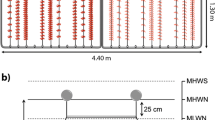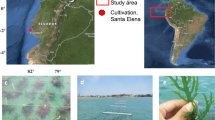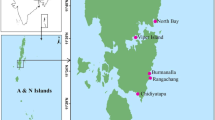Abstract
Gracilaria dura is an important red alga having the potential for commercial farming. To cultivate this alga, the floating bamboo raft method was employed. The study was carried out during October 2010 to September 2012 at the southeastern coast of India. The impacts of seasonal variation, initial seed density, harvest period, depth, and epiphyte and epifauna attachment on the raft were analyzed. A clear seasonal trend was observed in the biomass yield in G. dura in this 2-year study. The highest biomass yield (2.01 ± 0.68 kg FW m−2) and daily growth rate (DGR; 3.17 ± 1.71 % day−1) were observed in winter (January to March). ANOVA results also showed no significant variations between DGR and biomass yield between the first and second year (p > 0.05). The algal biomass decreased during summer (April to June) due to high surface seawater temperature and tissue bleaching. Maximum biomass yield and DGR were observed at a low initial seed density of 50 propagules m−2 (2 kg raft−1) with 45 days of culture period. The rafts cultivated in submerged condition showed a high growth rate (2.31 ± 1.35 % day−1); however, it did not vary significantly with cultivation at the surface level. Grazing was observed to be most severe during the months of April to August by selective fishes like Pteroscirtes mitratus, Siganus canaliculatus, Pelates quadrilineatus, and Monodactylus kottelati; the crab Portunus pelagicus; and the isopod Cymodoce truncata. From the 2-year study, it was found that October to March is the ideal period for the large-scale cultivation of this alga.






Similar content being viewed by others
References
Alveal K, Romo H, Werlinger C, Oliveira EC (1997) Mass cultivation of the agar producing alga Gracilaria chilensis (Rhodophyta) from spores. Aquaculture 148:77–83
Andersen GS, Steen H, Christie H, Fredriksen S (2011) Moy FE (2011) Seasonal patterns of sporophyte growth, fertility, fouling, and mortality of Saccharina latissima in Skagerrak, Norway: implications for forest recovery. J Mar Biol. doi:10.1155/2011/690375
Anderson RJ, Levitt GJ, Share A (1996) Experimental investigations for the mariculture of Gracilaria in Saldhana Bay, South Africa. J Appl Phycol 8:421–430
Armisen R (1995) World-wide use and importance of Gracilaria. J Appl Phycol 7:231–243
Bixler HJ, Porse H (2011) A decade of change in the seaweed hydrocolloids industry. J Appl Phycol 23:321–335
Buschmann AH, Westermeier R, Retamales C (1995) Cultivation of Gracilaria in the sea-bottom in southern Chile: a review. J Appl Phycol 7:291–301
Buschmann AH, Briganti F, Retamales CA (1997) Intertidal cultivation of Gracilaria chiliensis (Rhodophyta) in southern Chile: long term invertebrate abundance patterns. Aquaculture 156:269–278
Buschmann AH, Correa JA, Westermeier R, Hernández-González MC, Norambuena R (1999) Mariculture of red algae in Chile. World Aquaculture 30:41–45
Buschmann AH, Correa JA, Westermeier R, Gonzalez MC, Norambuena R (2001) Red algal farming in Chile—a review. Aquaculture 194:203–220
Buschmann AH, Varela DA, Hernández-González MC, Huovinen P (2008) Opportunities and challenges for the development of an integrated seaweed-based aquaculture activity in Chile: determining the physiological capabilities of Macrocystis and Gracilaria as biofilters. J Appl Phycol 20:571–577
Cai J, Hishamunda N, Ridler N (2013) Social and economic dimensions of carrageenan seaweed farming: a global synthesis. In: Valderrama D, Cai J, Hishamunda N, Ridler N (eds) Social and economic dimensions of carrageenan seaweed farming, pp 5–59 Fisheries and Aquaculture Technical Paper No. 580. Rome, FAO. 204 pp
Chennbhotla VSK, Kaladharan P, Kaliaperumal N, Rajagobalan MS (1992) Seasonal variation in production of cultured seaweed Gracilaria edulis (Gmelin) Silva in Minicoy Lagoon (Lakshadweep). Seaweed Res Utiln 14:109–113
Chennubhotla VSK, Kaliaperumal N, Kalimuthu S (1978) Culture of Gracilaria edulis in inshore waters of Gulf of Mannar, Mandapam. Indian J Mar Sci 21:228–229
Chennubhotla VSK, Kaliaperumal N, Kalimuthu S, Ramalingam JR, Selvaraj M, Najmuddin M (1987) Seaweed culture. CMFRI Bull 41:60–74
Cole KM, Sheath RG (1990) Biology of red algae. Cambridge University Press, New York, pp 385–390
Critchley AT, Ohno M (1998) Seaweed resources of the world. Japan International Cooperation Agency, Yokosuka, p 431
Dawes CP (1995) Suspended cultivation of Gracilaria in the sea. J Appl Phycol 8:310–313
Dawes CJ, Lluisma AD, Trono CG (1993) Clonal propagation of Eucheuma denticulatum and Kappaphycus alvarezii for Philippine seaweed farms. Hydrobiologia 260/261:379–383
Day F (1958) The fishes of India. Vol. II. William Dawson & sons, Ltd pp:1-194
Doty MS (1986) Estimating returns from producing Gracilaria and Eucheuma on line farms. Monogr Biol 4:45–62
Dural B, Demir N, Sunlu U (2006) A pilot scale unit for suspended cultivation of Gracilaria gracilis in Izmir Bay, Aegean sea-Turkey. Pak J Biol Sci 9(6):1043–1046
Edding M, Macchiavello J, Black H (1987) Culture of Gracilaria sp. in outdoor tanks: productivity. Hydrobiologia 151/152:369–373
Enright CT (1979) Competitive interaction between Chondrus crispus (Florideophyceae) and Ulva lactuca (Chlorophyceae) in Chondrus aquaculture. Proc Int Seaweed Symp 9:209–218
Eswaran K, Ghosh PK, Mairh OP (2002) Experimental field cultivation of Kappaphycus alvarezii (Doty) Doty ex. P. Silva at Mandapam region. Seaweed Res Utiln 24:67–73
Fletcher RL (1995) Epiphytism and fouling in Gracilaria cultivation: an overview. J Appl Phycol 7:325–333
Friedlander M, Gonen Y, Kashman Y, Beer S (1996) Gracilaria conferta and its epiphytes. 3. Allelopathic inhibition of the red seaweeds by Ulva lactuca. J Appl Phycol 8:21–25
Ganesan M, Thiruppathi S, Jha B (2006a) Mariculture of Hypnea musciformis (Wulfen) Lamouroux in south east coast of India. Aquaculture 256:201–211
Ganesan M, Thiruppathi S, Nivedita S, Rengarajan N, Veeragurunathan V, Jha B (2006b) In situ observations on preferential grazing of seaweed by some herbivores. Curr Sci 91(9):1256–1260
Ganesan M, Sahu N, Eswaran K (2011) Raft culture of Gracilaria edulis in open sea along the south-eastern coast of India. Aquaculture 321:141–151
Han T, Han YS, Kain JM, Häder DP (2003) Thallus differentiation of photosynthesis, growth, reproduction, and UV-B sensitivity in the green alga Ulva pertusa (Chlorophyceae). J Phycol 39:712–721
Hanelt D, Wiencke C, Nultsch W (1997) Influence of UV radiation on the photosynthesis of Arctic macroalgae in the field. J Phytochem Photobiol B 38:40–47
James PSBR, Chennubhotla VSK, Rodrigo JX (1986) Studies on the fauna associated with the cultured seaweed Gracilaria edulis. Proc Symp Coastal Aquaculture MBAI Cochin, pp 1193-1198
Jara F (1990) Epidemic outbreaks of herbivorous annelid worms (Polychaeta: Nereididae) in the south of Chile. Medio Ambiente 11:65–75
Kaladharan P, Chennubhotla VSK (1993) Introduction and growth of Gracilaria edulis in Minicoy lagoon. Fishing Chimes 13:55
Kaladharan P, Vijayakumaran K, Chennubhotla VSK (1996) Optimization of certain physical parameters for the mariculture of Gracilaria edulis (Gmelin) Silva in Minicoy lagoon (Luccadive archipelago). Aquaculture 139:265–270
Kaliaperumal N, Chennubhotla VSK, Kalimuthu S, Ramalingam JR, Muniyandi K (1993) Growth of Gracilaria edulis in relation to environmental factors in field cultivation. Seaweed Res Utiln 16:167–176
Kaliaperumal N, Ezhilvalavan R, Ramalingam JR (2001) Studies on salinity tolerance and acclimatization of some commercially important seaweeds. Seaweed Res Utiln 23:47–53
Kaliaperumal N, Kalimuthu S, Ramalingam JR (2003) Pilot scale field cultivation of the agarophyte Gracilaria edulis (Gmelin) Silva at Vadakadu (Rameswaram). Seaweed Res Utiln 25:213–219
Krishnamurthy V (1991) Gracilaria resources of India with particular reference to Tamilnadu coast. Seaweed Res Utiln 14:1–8
Kushel FA, Buschmann AF (1991) Abundance, effects and management of epiphytism in intertidal cultures of Gracilaria (Rhodophyta) in Southern Chile. Aquaculture 92:7–19
Li RZ, Chang RY, Meng ZC (1984) A preliminary study of raft cultivation of Gracilaria verrucosa and Gracilaria sjoestedtii. Hydrobiologia 116/117:225–254
Luhan RJ (1996) Biomass and reproductive studies of Gracilaria heteroclada Zhary et Xia collected from Jaro, Central Philippines. Bot Mar 39:207–211
Mal TK, Subbaramaiah K (1990) Growth and seasonality of reproductive phases of Gracilaria edulis (Gmel.) Silva in the Gulf of Mannar. Seaweed Res Utiln 13:97–100
Mantri VA, Thakur MC, Kumar M, Reddy CRK, Jha B (2009) The carpospore culture of industrially important red alga Gracilaria dura (Gracilariales, Rhodophyta). Aquaculture 297:85–90
McLachlan J, Bird CJ (1986) Gracilaria (Gigartina, Rhodophyta) and productivity. Aquatic Bot 26:27–49
Meena R, Chaudhary JP, Agarwal PK, Maiti P, Chatterjee S, Raval HD, Agarwal P, Siddhanta AK, Prasad K, Ghosh PK (2014) Surfactant-induced coagulation of agarose from aqueous extract of Gracilaria dura seaweed as an energy-efficient alternative to the conventional freeze-thaw process. RSC Advances 4:28093–28098
Molloy FJ, Bolton JJ (1995) Distribution, biomass and production of Gracilaria in Luderitz Bay, Namibia. J Appl Phycol 7:381–392
Msuya FE (2013) Effects of stocking density and additional nutrients on growth of the commercially farmed seaweeds Eucheuma denticulatum and Kappaphycus alvarezii in Zanzibar Tanzania. Tanzania J Nat Appl Sci 4(1):605–612
Murthy MS, Ramakrishna T, Rao YN, Ghose DK (1989) Ecological studies on some agarophytes from Veraval Coast, India. I. Effects of aerial conditions on biomass dynamics. Bot Mar 32:515–520
Oliveira VP, Freire FAM, Soriano EM (2012) Influence of depth on the growth of the seaweed Gracilaria birdiae (Rhodophyta) in a shrimp pond. Braz J Aquat Sci Technol 16:33–39
Padhi S, Prasanna K, Sasmitha S, Behura K, Baidya S, Santosh Behera K, Manas Panigrahy R (2011) Cultivation of Gracilaria verrucosa (Huds) Papenfuss in Chilka Lake for livelihood generation in coastal areas of Orissa state. J Appl Phycol 23:151–155
Pereira R, Yaris C, Sousa-Pinto I (2006) The influence of stocking density, light and temperature on the growth, production and nutrient removal capacity of Porphyra dioica (Bangiales, Rhodophyta). Aquaculture 252:66–78
Pizarro A (1986) Conocimiento actual y avances recientes sobre el manejo y cultivo de Gracilaria en Chile. Monogr Biol 4:63–96
Pizarro A, Barrales H (1986) Field assessment of two methods for planting the agar containing seaweed, Gracilaria in northern Chile. Aquaculture 59:31–43
Raju PV, Thomas PC (1971) Experimental field cultivation of Gracilaria edulis (Gmel.) Silva. Bot Mar 14:71–75
Rama Rao K, Subbaramaiah K (1977) Regeneration and re-growth of Gelidiella acerosa (Forssk.) Feldmann et Hamel at Kilakkarai southeastern shores of India. Indian J Mar Sci 6:175–177
Rebello J, Ohno M, Ukeda H, Sawamura M (1996) Agar quality of commercial agarophytes from different geographical origin. I. Physical and rheological properties. J Appl Phycol 8:517–521
Rotmann KWG (1987) The collection, utilization and potential farming of red seaweeds in Namibia. Hydrobiologia 151/152:301–305
Santelices B, Vasqueza J, Ohme U, Fonck E (1984) Managing wild crops of Gracilaria in Central Chile. Hydrobiologia 116/117:79–89
Siddhanta AK, Meena R, Prasad K, Ramavat BK, Ghosh PK, Eswaran K, Thiruppathi S, Mantri VA (2005) A cost effective process for preparing agarose from Gracilaria spp. PCT Patent W0 2005/118830 A1.
Strickland JDH, Parsons TR (1972) A practical handbook of seawater analysis. Bull Fish Res Bd Canada 67:1–311
Subbaramaiah K, Thomas PC (1990) Raft cultivation of Gracilaria edulis (Gmel.) Silva. Proc Ind Acad Sci (Plant Sci.) 100:123–127
Systat (1997) User manual and reference manual for Systat V.7.0 for Windows. Statistical Package for the Social Science Inc, Chicago, IL.
Talwar PK, Kacher RK (1984) Commercial sea fishes of India. Zoological Survey of India, Calcutta, pp 1–230
Troell M, Halling C, Nilsson A, Buschmann AH, Kautsky N, Kautsky L (1997) Integrated marine cultivation of Gracilaria chilensis (Gracilariales, Rhodophyta) and salmon cages for reduced environmental impact and increased economic output. Aquaculture 156:45–61
Umamaheswara Rao M (1973) Growth and reproduction in some species of Gracilaria and Gracilariopsis in the Palk Bay. Indian J Fish 20:182–192
Ummamheswara Rao M (1974) On the cultivation of Gracilaria edulis in the near shore areas around Mandapam. Curr Sci 43(20):600–661
Veeragurunathan V (2009) Impact of light intensity and salinity on the growth of Gracilaria corticata (J.) Agardh. Seaweed Res Utiln 31:37–41
Wakibia JG, Anderson RJ, Keats DW (2001) Growth rates and agar properties of three gracilarioids in suspended open-water cultivation in St. Helena Bay, South Africa. J Appl Phycol 13:195–207
Westermeier R, Gómez I, Rivera P (1993) Suspended farming of Gracilaria chilensis (Rhodophyta, Gigartinales) at Cariquilda River, Maullín, Chile. Aquaculture 113:215–229
Xu J, Gao K (2008) Growth, pigments, UV absorbing compounds and agar yield of the economic red seaweed Gracilaria lemaneiformis (Rhodophyta) grown at different depths in the coastal waters of the South China Sea. J Appl Phycol 20:681–686
Yang Y-F, Fei X-G, Song J-M, Hai-Yan H, Wang G-C, Chung IK (2006) Growth of Gracilaria lemaneiformis under different cultivation conditions and its effects on nutrient removal in Chinese coastal waters. Aquaculture 254:248–255
Zacher K, Roleda MY, Hanelt D, Wiencke C (2007) UV effects on photosynthesis and DNA in propagules of three Antarctic seaweeds (Adenocystis utricularis, Monostroma hariotii and Porphyra endiviifolium). Planta 225:1505–1516
Acknowledgments
The financial support by the Council of Scientific and Industrial Research (CSIR), New Delhi, is gratefully acknowledged. The authors expressed their sincere thanks to Dr. P. K. Ghosh, Director, CSMCRI for his keen interest in this study and providing facilities to carry out the experiments. The authors thank Dr. C. R. K. Reddy, group leader, seaweed group, CSMCRI, for his periodical review of the successful cultivation of G. dura. The authors also expressed their gratitude to Mr. K. Karthikeyan, Mr. B. Prince Vijay, and Mr. S. Sirajudeen, ex-project assistants, and Mr. A. Sathakku, ex-technical assistant, MARS, Mandapam for their contribution in cultivation. This contribution has CSIR-CSMCRI PRIS registration number 118/2014.
Author information
Authors and Affiliations
Corresponding author
Rights and permissions
About this article
Cite this article
Veeragurunathan, V., Eswaran, K., Malarvizhi, J. et al. Cultivation of Gracilaria dura in the open sea along the southeast coast of India. J Appl Phycol 27, 2353–2365 (2015). https://doi.org/10.1007/s10811-014-0514-0
Received:
Revised:
Accepted:
Published:
Issue Date:
DOI: https://doi.org/10.1007/s10811-014-0514-0




